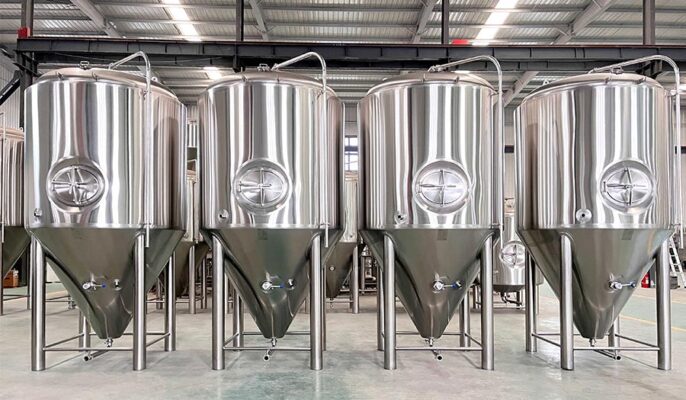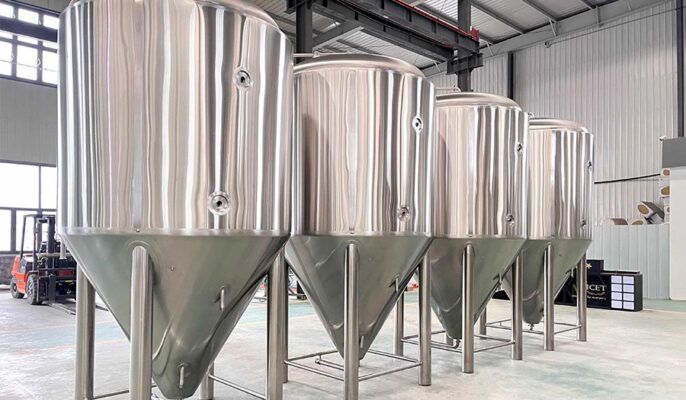Beer fermentation is the most important step in the beer brewing process, and choosing the right fermenter is an important step in producing beer. For homebrewers looking to improve their brewing, conical fermenters offer a range of advantages that can improve the quality of the brew and simplify the process. While they are often seen as equipment for advanced brewers, beginners can also take full advantage of their features. Buying a conical fermenter is very important, and this guide will help you with how to buy a conical fermenter and what tips are available.
유형 beer fermenters
원뿔형 발효기
Conical fermenters are the most common type of fermenter used in the brewing industry. Its unique shape separates the yeast and sediment from the beer, simplifying the cleaning and harvesting process. Conical fermenters also provide better temperature control and can handle both primary and secondary fermentations.
Single Tank Fermenter
Single-tank fermenters, also known as conical fermenters, combine the characteristics of both fermenters and conditioning tanks. They can perform primary and secondary fermentation as well as conditioning and maturation in a single tank. Single-tank fermenters are favored by many breweries for their versatility and space-saving design.
오픈 발효기
Traditionally used for the production of certain beer types, such as Belgian ales, open fermenters provide an exposed surface for the yeast to come into contact with air. This method typically produces distinctive flavors and aromas, as well as increased ester production. However, open fermenters require careful sanitation to prevent contamination.
Horizontal fermenters
Horizontal fermenters are less common but are useful in specific brewing installations. They are often used for beer fermentation and aging because horizontal placement allows for better contact between the beer and the yeast, resulting in smoother, rounder flavors.

Conical Fermenter Basics
A conical fermenter is a piece of equipment specifically designed for use in the fermentation process of brewing beer, wine, and more. It gets its name from its characteristic conical bottom design, which plays a key role in the brewing process. It has a conical bottom that collects and removes sediment, such as yeast and lees, during the fermentation process. This unique design separates the beer from unwanted debris, resulting in a clearer, cleaner end product.
Conical fermenters are typically made of food-grade stainless steel for excellent durability, ease of cleaning, and temperature control. There is also a valve at the bottom of the vessel, often referred to as a pipette valve, which allows for easy transfer of beer without disturbing the sediment.
Conical fermenters are versatile and can be used for all types of beer fermentation. Whether you are brewing an ale, lager, or sour beer, a conical fermenter has the flexibility to accommodate different styles and yeast strains. This versatility makes them a popular choice for home brewers and commercial breweries alike.
맥주 발효기용 재료
There are several types of fermenters available to home brewers, each with its pros and cons.
- Plastic Fermenters: These fermenters are lightweight, affordable, and easy to clean. They are usually made of food-grade plastic and come in a variety of shapes and sizes. The downside of plastic fermenters is that they scratch easily, which can harbor bacteria and affect the flavor of the beer. In addition, they may not be as durable as other options.
- Glass Fermenters: Glass fermenters, usually large glass carboys, are popular among home brewers due to their non-porous nature, which reduces the risk of contamination. They are also more scratch-resistant than plastic fermenters. However, glass fermenters are heavy, fragile, and difficult to clean due to their narrow openings.
- Stainless Steel Fermenters: Stainless steel fermenters are preferred by many professional brewers because they are durable, easy to clean, and resistant to scratches and contamination. While they may be more expensive than plastic or glass fermenters, they are an excellent long-term investment for serious homebrewers.
- Conical Fermenters: Conical fermenters are a popular choice for homebrewers who want to simplify the brewing process. The conical design allows for easy removal of yeast and sediment without the need to transfer to a secondary fermenter. These fermenters can be made of plastic, glass, or stainless steel.
선택해야 하는 이유 conical fermenter?
원뿔형 바닥
The most distinctive feature of a conical fermenter is the conical or beveled shape of its bottom. This design allows the fermenter to naturally deposit yeast and other suspended material (e.g. lees, tartar) to the bottom of the tank. By adjusting the angle of the bottom, the collection and discharge of sediment can be controlled, thus helping to maintain the clarity and purity of the wine.
내구성 및 수명
Stainless steel is a very durable material that can withstand high temperatures and pressures, making it ideal for fermenters. With proper care, stainless steel fermenters can last for many years. This means you only need to invest in a quality fermenter once and enjoy the benefits for a long time.
손쉬운 세척 및 살균
One of the biggest benefits of stainless steel fermenters is that they are easy to clean and sanitize. Stainless steel is non-porous, which means it is resistant to bacteria and other microorganisms. This makes it easy to clean your fermenter before and after each use. You can use non-abrasive cleaners and sanitizers to avoid damaging the stainless steel.
온도 제어
Temperature control is critical during the fermentation process. Stainless steel has excellent thermal conductivity, which means it can maintain a consistent temperature throughout the fermentation process. This is important for producing high-quality beer. Some fermenters even have a double-layer design with an outer jacket for precise temperature control.

Tips for Buying Conical Fermenters
- Surface and material: the material of beer cans can be made of stainless steel or carbon steel, but if carbon steel is chosen, the inner wall of beer cans must be coated with a non-toxic coating that does not affect the taste of beer. The inside wall of beer cans must be smooth and flat, and the inside wall of stainless steel beer cans should be polished. Carbon steel beer cans should be evenly coated on the inside, with no unevenness, and no granular protrusions.
- Capacity and size : Determine the size of your brew and choose the appropriate capacity. A tank that is too small may result in uneven fermentation or insufficient containment, while one that is too large may waste space and resources. Make sure the size of the conical fermenter fits your winery or home brewing space, including ease of storage and cleaning.
- Brewing type: The type of beer being brewed will also affect the size of the fermenter you need. For example, if you want to brew a lager or other beer that requires precise temperature control, you may need to use a jacketed fermenter. These fermenters may be larger and more expensive, but they allow for better control of the fermentation process.
- Tank taper angle: The taper angle of the tank is usually between 60° and 90°, commonly 60° to 75° (60° for stainless steel tanks and 75° for carbon steel tanks are common) to facilitate settling and separation of the yeast.
- Cooling jacket and area: depending on the capacity of the tank, the cooling can be two-stage or three-stage, the cooling area depends on the material of the tank, and the cooling area of the bottom of the cone should not be too large to prevent the beer from freezing during the storage period.
- Pressure resistance of the tank: During beer fermentation, the tank will produce carbon dioxide, forming pressure on the top of the tank, so the fermentation tank should be installed with a vacuum relief valve. Carbon dioxide discharge, the beer outflow rate is too fast, the fermenter flushing process of carbon dioxide dissolution, the tank produces negative pressure, so the vacuum valve must be installed.
- diameter to height ratio: the diameter to height ratio of the tank is usually 1:2 to 1:4, the total height of the best not more than 16 m. Generally, the larger the diameter-to-height ratio, the stronger the natural convection during fermentation, the faster the yeast fermentation, but the yeast is not easy to settle, and the beer is not easy to clarify.
Using and Maintaining a Stainless Steel Fermenter
After choosing a stainless steel fermenter, it is important to understand how to properly use and maintain it. Here are some maintenance methods:
- Cleaning and disinfection: Always clean and sanitize your fermenter thoroughly before using it. Use non-abrasive cleaners and sanitizers to avoid damaging the stainless steel.
- Temperature Control: Maintaining a constant temperature is important for the fermentation process. If your fermenter does not have a jacket for temperature control, you can use a thermostat or constant temperature chamber.
- Oxygen and: During fermentation, yeast needs oxygen to reproduce and produce alcohol. Be sure to oxygenate the wort before adding the yeast. You can do this by shaking the fermenter or using an oxygenation stone.
- Fermentation Time: The length of fermentation depends on the type of beer you are brewing and the strain of yeast used. Generally, fermentation takes one to two weeks. Once fermentation is complete, you can transfer the beer to another vessel for further aging.




